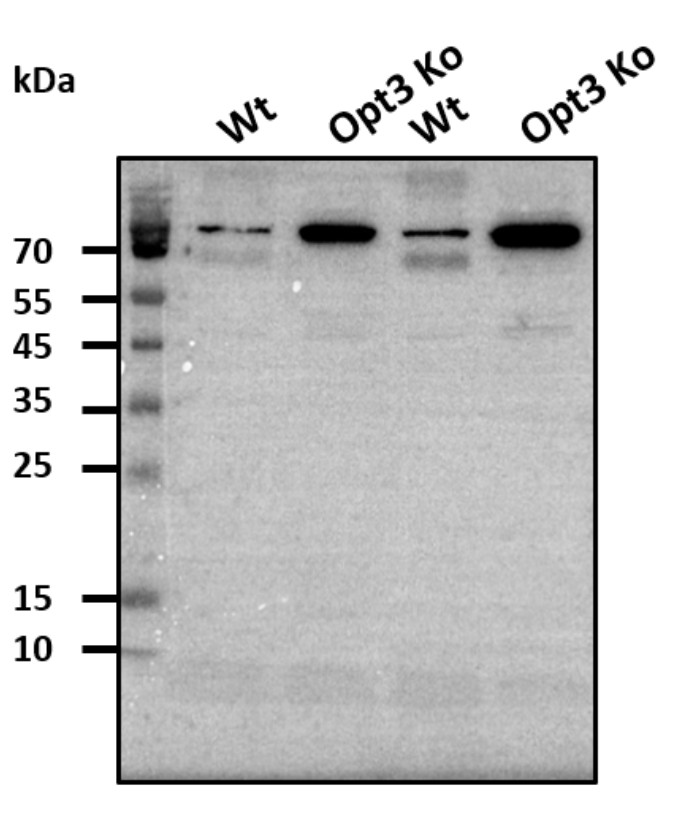1

OPT3 | Oligopeptide transporter 3
AS22 4879 | Clonality: Polyclonal| Host: Rabbit | Reactivity: Arabidopsis thaliana
- Product Info
-
Immunogen: KLH-conjugated peptide derived from Arabidopsis thaliana OPT3 protein, UniProt: O23482 TAIR: AT4G16370 Host: Rabbit Clonality: Polyclonal Purity: Antigern affinity purified serum, in PBS pH 7.4 Format: Lyophilized Quantity: 50 µg Reconstitution: For reconstitution add 50 µl, of sterile or deionized water. Storage: Store lyophilized/reconstituted at -20°C; once reconstituted make aliquots to avoid repeated freeze-thaw cycles. Please, remember to spin tubes briefly prior to opening them to avoid any losses that might occur from lyophilized material adhering to the cap or sides of the tubes. Tested applications: Western blot (WB) Recommended dilution: 1 : 1000 (WB) Expected | apparent MW: 82,4 kDa - Reactivity
-
Confirmed reactivity: Arabidopsis thaliana Predicted reactivity: Capsella rubella, Camelina sativa
For other species: inquire about free sample of AS22 4879
Species of your interest not listed? Contact usNot reactive in: No confirmed exceptions from predicted reactivity are currently known - Application Examples
-

40-60 μg/well of total proteins were extracted from 10-day old Arabidopsis thaliana seedlings grown on 0.5X strength Murashige & Skoog media supplemented with 1% sucrose. Col-0 ecotype (wild-type, WT) and opt3-2 T-DNA insertion knock-down mutant (Khan et al., 2018) were used to test OPT3 protein abundance using Agrisera OPT3 antibody (Cat.No. 224879, Lot.2311). Proteins were denatured at 65°C for 5 min, separated on an 15 % SDS-PAGE and transferred for 70 min at 65V using a tank transfer system to nitrocellulose membrane as described in (LaMontagne et al., 2016). Blots were blocked with 1X PBS + 0.1% Tween20 (PBS-T) + 5% milk for 2 h at room temperature (RT) with agitation. Primary antibodies were diluted in PBS-T milk to 1: 5,000 and incubated overnight at 4oC with agitation. Primary antibody solutions were decanted, and blots were washed 3 times (7 minutes each) in 1xPBS-T with agitation. Blot was incubated with secondary antibody goat anti-rabbit HRP conjugated (AS09 602, Agrisera) diluted to 1: 7 500 at RT and developed with chemiluminescent detection reagent according to manufacture recommendations. Exposure time was 1 minute on X-ray films. MPK6 antibody served as loading control.
Results: Lower OPT3 band intensity was detected in opt3-2 knock-down mutant compared to Arabidopsis thaliana wild-type ecotype Col-0.
Courtesy of Nga Nguyen and Antje Heese (University of Missouri- Columbia, MO, USA)
Samples, from the left:
1- MW markers
2,4 - 50 ug of Arabidopsis thaliana whole leaf extract
3,5 - 50 ug of Arabidopsis thaliana OPT3 overexpressing mutantNormalized on fresh weight of a leaf disk of total protein extracted freshly from Arabidopsis thaliana leaf. Exact buffer components were: 50mM Tris pH 7.5, 150mM NaCl, 10% glycerol 2 mM EDTA, protease inhibitor mix, 1% SDS and denatured with (1% mercaptoethanol, 0.01% bromphenol blue, 6% glycerol, 2% SDS, 50 mM Tris pH 6.8) at 80 °C/ 10 min. Samples were separated at RT on 12.5 % SDS-PAGE and blotted for overnight approx. 17h at 4°C on PVDF using: wet, in the cold. Blot was blocked with 5% milk 1h/RT with agitation. Blot was incubated in the primary antibody at a dilution of 1: 1000 ON/4°C with agitation. The antibody solution was decanted, and the blot was rinsed briefly twice, then washed once for 15 min and 3 times for 5 min in TBS-T at RT with agitation. Blot was incubated with a matching secondary antibody (anti-rabbit IgG horse radish peroxidase conjugated) diluted to 1: 20 000 in for 1.5h/RT with agitation. The blot was washed as above and developed with a following chemiluminescent detection reagent: Agrisera Bright (AS16 ECL-N) . Exposure time was about 10-20 seconds.
Courtesy of Phd student Lorenz Holzmer, Kunz Lab, LMU Munich, Germany
- Background
-
Background: OPT3 (Oligopeptide transporter 3) is a phloem-specific iron transporter that is essential for systemic iron signaling and redistribution of iron and cadmium. Involved in ion homeostasis, xylem-to-phloem iron transport and Ion homeostasis and essential for early embryo development. Alternative name: AtOPT3. - Protocols
-
Agrisera Western Blot protocol and video tutorials
Protocols to work with plant and algal protein extracts
Agrisera Educational Poster Collection - Reviews:
-
This product doesn't have any reviews.

